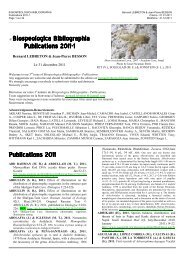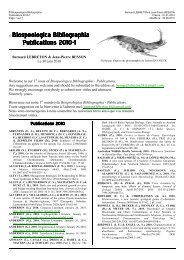Biospeologica Bibliographia Publications 2010-2
Biospeologica Bibliographia Publications 2010-2
Biospeologica Bibliographia Publications 2010-2
Create successful ePaper yourself
Turn your PDF publications into a flip-book with our unique Google optimized e-Paper software.
© <strong>Biospeologica</strong> <strong>Bibliographia</strong><br />
<strong>Publications</strong> <strong>2010</strong>-1<br />
Page 32 sur 116<br />
evolution of species in underground systems in the world is based on<br />
these climatic changes occurring during distinct glacial maxima.<br />
However, the great amount of new species recently discovered in<br />
Brazilian caves and their high degree of troglomorphism indicates, that<br />
the events of climatic changes in Neotropics, even if not so severe as in<br />
temperate regions, could have led to the isolation of subterranean<br />
lineages. Or, alternatively, other mechanisms of isolation (e. g. parapatric<br />
speciation, oceanic introgressions and regressions), might have led to the<br />
evolution of many lineages of subterranean fauna in Brazil. Furthermore,<br />
especially for terrestrial troglobionts, it seems that there is a geographic<br />
belt in northeastern Brazil (from SW to NE) in which troglobiotic species<br />
are concentrated. This belt eventually can represent the area in which<br />
many ancient populations had first become isolated due to the separation<br />
of the continuous evergreen tropical forest that used to exist in the area<br />
during the last glacial maximum, when the Amazon forest and the<br />
Brazilian Atlantic forest were connected. The Neotropical region is also<br />
characterized by the huge diversity of higher taxonomic groups of<br />
subterranean animals, what makes it especially interesting for ecological<br />
studies. http://www.icsb<strong>2010</strong>.net/<br />
FERREIRA (R. L.) & SOUZA-SILVA (M.), <strong>2010</strong>. The<br />
cave lithology determining the structure of the cave<br />
invertebrate communities in the Brazilian Atlantic rain<br />
forest:44-45, poster presentation. In: 20 th International<br />
Conference on Subterranean Biology, Postojna, Slovenia,<br />
29 August-3 September <strong>2010</strong>, ICSB <strong>2010</strong> Abstract Book,<br />
edited by: Ajda MOŠKRIČ and Peter TRONTELJ, ISBN<br />
978-961-269-286-5. ABS: Only limestone and a few arenitic,<br />
ferruginous and granitic caves had their invertebrate communities<br />
studied. The present study aimed to compare the structure of invertebrate<br />
communities associated with carbonatic, magmatic, siliciclastic and<br />
ferruginous caves. Significant differences related to richness were<br />
observed when comparing pairs of caves: siliciclastitic and carbonatic,<br />
ferruginous and siliciclastic, magmatic and siliciclastic, and magmatic<br />
and ferruginous. Significant differences in relative abundance were<br />
observed between ferruginous and siliciclastic caves, and magmatic and<br />
siliciclastic caves. Ferruginous caves had the highest richness of<br />
troglomorphic species. Total richness of invertebrates was significantly<br />
positively correlated with cave length regardless of lithology. Relative<br />
richness and relative diversity of invertebrates in siliciclastic caves was<br />
positively related with the altitudinal variation. Total species richness of<br />
invertebrates was significantly positively corrrelated with environmental<br />
stability in siliciclastic caves. Total abundance of invertebrates was<br />
significantly positively correlated with environmental stability in<br />
carbonatic caves. Cave lithology determines clear differences in richness,<br />
abundance, and diversity of subterranean invertebrate communities.<br />
Ferruginous caves have the highest richness, and fauna composition most<br />
different from caves of other lithologies. Linear development of caves in<br />
different rock types causes difference in amount of species. Cave size<br />
should always be considered along with lithology when different caves<br />
are biologically evaluated. http://www.icsb<strong>2010</strong>.net/<br />
F. G., <strong>2010</strong>. Lascaux: "Les fresques se portent bien". Le<br />
Nouvel Observateur 2406(16-22 Décembre):109.<br />
FILIPPOVA (A.), PURSCHKE (G.), TZETLIN (A. B.) &<br />
MÜLLER (M. C. M.), <strong>2010</strong>. Musculature in polychaetes:<br />
comparison of Myrianida prolifera (Syllidae) and<br />
Sphaerodoropsis sp. (Sphaerodoridae). Invertebrate<br />
Biology 129(2, Spring):184-198. ABS. The relationship of the<br />
polychaete taxa Syllidae and Sphaerodoridae within Phyllodocida is still<br />
unresolved: phylogenetic analyses either show them as sister groups or<br />
more widely separated. The present article aims to provide information<br />
about the structure of the muscular system that could be essential for<br />
understanding their relationship. A crucial point is whether the body wall<br />
contains circular muscles, which has recently been shown to be absent in<br />
more taxa than previously known. The F-actin filaments in members of<br />
Myrianida prolifera (Syllidae) and Sphaerodoropsis sp. (Sphaerodoridae)<br />
were labeled with phalloidin and their three-dimensional relationships<br />
reconstructed by means of confocal laser scanning microscopy. Among<br />
the noteworthy differences that emerged between the species are (1)<br />
members of M. prolifera possess four, those of Sphaerodoropsis sp. eight,<br />
longitudinal muscle strands; (2) the body wall in M. prolifera contains<br />
transverse fibers in a typical, supralongitudinal position, while in<br />
Sphaerodoropsis sp., corresponding fibers lie beneath the longitudinal<br />
strands; (3) pro- and peristomium in M. prolifera have no distinct F-actin<br />
fibers, while five longitudinal pairs and three single transverse muscular<br />
Bernard LEBRETON & Jean-Pierre BESSON<br />
Créé le : 01.01.<strong>2010</strong><br />
Modifié le : 30.06.<strong>2010</strong><br />
fibers shape the anterior end in Sphaerodoropsis sp.; (4) the proventricle<br />
of M. prolifera comprises primarily radial muscle fibers arranged in<br />
distinct rows, while in Sphaerodoropsis sp. the axial proboscis consists of<br />
longitudinal and circular fibers and radial fibers are lacking; (5) in M.<br />
prolifera, the proximal and distal sections of the two anteriormost pairs of<br />
dorsal cirri possess longitudinal myofilaments, which are separate from<br />
the body wall musculature; by contrast, all appendages in<br />
Sphaerodoropsis sp. do not; (6) both species have bracing muscles: in M.<br />
prolifera they are positioned above the longitudinal fibers, whereas in<br />
Sphaerodoropsis sp. they are uniquely positioned between longitudinal<br />
and sublongitudinal transverse fibers. These results do not support a<br />
sister-group relationship of Syllidae and Sphaerodoridae. In addition,<br />
Sphaerodoropsis sp. is yet another example in the list of polychaetes<br />
lacking typical circular muscles in the body wall. KW: Annelida,<br />
phalloidin, F-actin, evolution, proventricle.<br />
http://onlinelibrary.wiley.com/doi/10.1111/j.1744-<br />
7410.<strong>2010</strong>.00191.x/abstract<br />
FIOLHAIS (C.), <strong>2010</strong>. Portugal subterrâneo. Sol, 3 de<br />
Dezembro.<br />
http://sol.sapo.pt/inicio/Opiniao/interior.aspx?content_id=6028&opiniao=<br />
Opini%E3o<br />
FIŠER (C.) & TRONTELJ (P.), <strong>2010</strong>. Adaptive morphology<br />
of subterranean amphipod communities:165-166. In: 20 th<br />
International Conference on Subterranean Biology,<br />
Postojna, Slovenia, 29 August-3 September <strong>2010</strong>, ICSB<br />
<strong>2010</strong> Abstract Book, edited by: Ajda MOŠKRIČ and Peter<br />
TRONTELJ, ISBN 978-961-269-286-5. ABS: Morphological<br />
evolution of subterranean species has been hitherto studied in relation to<br />
surface species. Still, closely related subterranean species co-exist at a<br />
number of sites. The stability of such communities implies nicheseparation<br />
and thereby minimized competition. Consequently, co-existing<br />
species are expected to differ in their functional morphology. In this study<br />
we analyzed 16 niphargid communities consisting of minimally three<br />
species, both from caves and interstitial habitats. In 33% of the cave<br />
communities and 63% of the interstitial communities the species were<br />
more dissimilar than expected if communities were assembled by chance.<br />
We searched for parallel morphological differentiation independently<br />
occurring across communities, and for evidence for the adaptive value of<br />
morphological differences. In cave communities, Principal Component<br />
Analysis (PCA) clearly distinguished three eco-types, i. e. phreatic, lentic,<br />
and epikarstic species. The three habitats can be described by pore size<br />
and water velocity. Phreatic species are large and stout with elongated<br />
appendages. Species from streams are large and slender with short<br />
appendages, and species form crevices are small and of various shapes<br />
and proportions. Covariance analysis of morpho-traits suggests that pore<br />
size affects evolution of body length, and water velocity affects the length<br />
of appendages. Interstitial communities consist of small and stout, small<br />
and vermiform, and larger and slender species. The third type may be<br />
opportunists, typically found also outside interstitial communities.<br />
Differences among species in this homogenous habitat cannot be<br />
explained by physical parameters, but the morphological types might<br />
differ in their trophic niche. To test this hypothesis, we compiled another<br />
set of measurements describing gnathopod shape as a surrogate for<br />
feeding ecology. Both datasets were separately subjected to PCA. In both<br />
datasets the first Principal Component explained over 90% of variation.<br />
First Principal Components from both datasets significantly correlated<br />
with each other. Slender community member with large gnathopods are<br />
presumable predators, while stouter species with feeble gnathopods are<br />
presumable microfeeders. http://www.icsb<strong>2010</strong>.net/<br />
FIŠER (Ž.), MOŠKRIČ (A.) & FIŠER (C.), <strong>2010</strong>. A<br />
molecular test for Niphargus krameri (Crustacea:<br />
Amphipoda) intraspecific diversity:57, poster presentation.<br />
In: 20 th International Conference on Subterranean<br />
Biology, Postojna, Slovenia, 29 August-3 September <strong>2010</strong>,<br />
ICSB <strong>2010</strong> Abstract Book, edited by: Ajda MOŠKRIČ and<br />
Peter TRONTELJ, ISBN 978-961-269-286-5. ABS: The<br />
taxonomic research on amphipods in the Niphargus krameri species<br />
complex has had a long history, making it an educative example of an<br />
intensely studied taxon whose taxonomy kept unfolding proportionally<br />
with the amount of invested work. The first record dates to 1935 when<br />
Schnellenberg described N. puteanus ssp. krameri. S. Karaman raised it<br />
to the species level in 1954. Based on a minor morphological variation,<br />
he additionally described N. krameri f. spinulifemur and N. krameri ssp.<br />
timavi. Thirty years later, in 1984, G. Karaman identified autapomorphic





